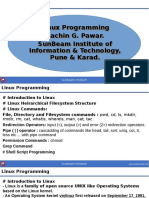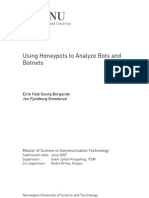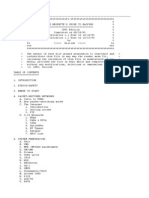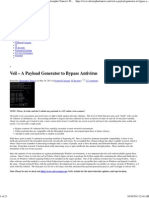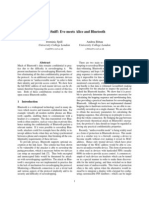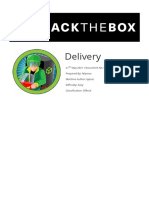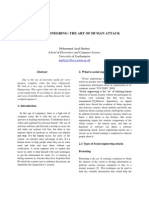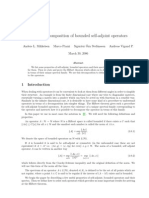Club Hack Magazine 05 PDF
Club Hack Magazine 05 PDF
Uploaded by
AlexxsCopyright:
Available Formats
Club Hack Magazine 05 PDF
Club Hack Magazine 05 PDF
Uploaded by
AlexxsOriginal Title
Copyright
Available Formats
Share this document
Did you find this document useful?
Is this content inappropriate?
Copyright:
Available Formats
Club Hack Magazine 05 PDF
Club Hack Magazine 05 PDF
Uploaded by
AlexxsCopyright:
Available Formats
Issue 5 June 2010 | Page - 1
Issue 5 June 2010 | Page - 2
Its time to close your leaking taps!!! In this
issue we will be covering the complex issue
of data leakage and ways to prevent it .
Since the issue of data loss is very
complicated , an open source solution must
be able to address this and that's the reason
we love open source community so much.
We will be having a look on the new tool
OpenDLP to keep an eye on your data.
Apart from DLP, which we have discussed
in our techgyan & toolgyan, we also have
our legal gyan of this month giving
information about law pertainning to data
theft & a real life case which happened in
India. Let's see how the court reacted to this
case. In our other regular sections , Mom's
guide is looking at yet another email scam
and command line gyan will give shortcuts
of finding text/string in bunch of files in an
easy
And Yeh! good
news for all you
Geeks,Nerds and
Hackers. Now you
can send in your
articles to us and
guess what we will
publish it in your
very own CHmag.
Send
in
your
articles
to info@chmag.in
way.
Issue 5 June 2010 | Page - 3
to many security and management related
challenges.
Data Loss
Prevention
Introduction
Information=Money! Information can be
anything financial statements, health
records
of patients, source
codes,
intellectual property (IP), trade secrets,
design specifications, price lists - anything
from which an organization generates
profits. Information is one of the businesss
most important assets.
Business requires accessing information
from anywhere, anytime and on any device.
This desire for information to be free leads
Organizations are moving from securing IT
infrastructure to securing Information.
While a great deal of attention has been
given to protecting electronic assets from
outside threats from IPS to Firewalls to
Vulnerability management organizations
are now turning their attention to an equally
dangerous situation: the problem of data
loss from inside.
Data Loss Problem
You may have got a complete arsenal of
hardware and software, encryption and
firewalls, IDS and IPS, to prevent any
hacker, virus, malware or spyware from
penetrating your defenses. From the outside
you are invincible.
Inside is a different story!
Issue 5 June 2010 | Page - 4
Inside, A Blackberry can be as dangerous as
an internal spy. Your email server may
become a superhighway for sending
classified data to the outside world. An
HTTP link can be a pipeline to the
competition.
The issue of data loss covers everything
from confidential information about one
customer being exposed, to thousands of
source code files for a companys product
being sent to a competitor. Whether
deliberate or Accidental, data loss occurs
any time. Employees, consultants, or other
insiders release sensitive data about
customers, finances, intellectual property,
or other confidential information (in
violation of company policies and regulatory
requirements).
According to a survey, Employee error is
now the fourth largest security concern in
the enterprise behind malware, spyware
and spam. With all the avenues available to
employees today to electronically expose
sensitive data, the scope of the data loss
problem is an order of magnitude greater
than threat protection from outsiders.
Sources of Data Leakage
There are many ways through which
confidential data or proprietary secrets can
leave an organization via the internet:
Data Loss Statistics
The charts below are provided in as-is
format based on the current database
maintained by Open Security Foundation
and DataLossDB.org .
Incidents by Vectors - All
Time
5% 3%
Inside
InsideAccidental
InsideMalicious
Outside
21%
8%
63%
Incidents Over Time
800
700
600
500
400
300
200
100
0
745
535
495
505
141
2005 2006 2007 2008 2009
E-mail
HTTP (message boards, blogs and
other websites)
Instant Messaging
Peer-to-peer sites and sessions
FTP
Flash drives, USB Devices, mp3 players, cell
phones, etc. are the most common
electronic devices used to leak sensitive
data.
151
2010
Issue 5 June 2010 | Page - 5
Data Loss Prevention
Data Loss Prevention (DLP) is a
system/process for identifying, monitoring
and protecting sensitive data on information
in an organization according to policies.
Policies can vary from organization to
organization, but the focus is on preventing
sensitive data from leaking out of the
organization and identifying people or
places that should not have access to certain
data or information.
DLP is also referred to as :- Information
Leak Prevention (ILP), Information Leak
Detection and Prevention (ILDP), Data Leak
Prevention, Content Monitoring and
Filtering (CMF), Information Protection
and Control (IPC), Extrusion Prevention
System, etc.
Sensitive Data and DLP Solution
Data in Motion
This feature of the DLP solution applies to
all data on wire. It is basically any data that
is moving through the network to the
outside via the internet.
Currently, there are various protocol
supported and HTTP, FRP, IM, P2P, SMTP
to name a few.
As shown below, all traffic leaving internal
network via any of the common channels
above will be mirrored to DLP for
inspection.
See the following example of placement of
this device:-
This provides visibility into a large number
of violations, For example, if a sensitive file
was transferred using FTP, there are several
things that will bring to light. FTP is a
protocol that uses cleat text. Transmitting
sensitive files in clear text becomes a
concern. This leads to the question if this
file should even be leaving the company.
Also we will need to verify if the parties
involved are authorized to view and
transmit data. Most of this applies not just
to FTP, but to any communication
mentioned above.
Data at Rest
This feature refers to any data that resides
in file systems, databases and other storage
methods. Primary use of this feature is for
finding sensitive data in the places where it
should not be i.e on corporate network,
employees laptops, backup media, etc. Once
it is found, data can be erased, moved to a
secured location or protected with access
privileges.
This uses the existing policy to look for any
sensitive data. Discovery scanning can be
used to fingerprint data to indentify
unstructured data elsewhere.
Data at Endpoints
Data at Endpoints constitutes agents that
run on end-servers, user laptops or
desktops, keeping watch on all activities
Issue 5 June 2010 | Page - 6
related to data. They typically monitor and
prevent any data leaving via removable
devices such as floppies, CDs, USB devices,
external devices, mp3 players etc.
Due to its agent based approach, it really
has not been a favorable solution among
customers. However it does provide a great
deal of protection against erasing data via
removable devices.
Best Practices to Prevent Data
Loss
Best Practice 1:Identify and Prioritize Your Most
Vulnerable Risk Points
Unwanted internal and external disclosure
of Non-Public Information (financial,
business, HR, legal, and regulatory data),
Personally Identifiable Information (social
security numbers, credit card information,
personal health data), and Intellectual
Property (patents, trademarks, design
plans) can occur at many different points
throughout your network. This is why a
comprehensive DLP solution ultimately has
to protect all potential risk points in your
organization.
While end-to-end protection of all
vulnerable sites is the ultimate goal for a
DLP solution, in reality, it makes far more
tactical and financial sense to begin by
protecting the data as well as the
mechanisms used to move this data that
represents the most danger to your
enterprise. As the most frequently accessed
and used electronic application in all
companies, email is, without question, the
most susceptible data loss risk point for
most enterprises. With literally every
employee in a typical organization sending
and receiving more than 100 messages
every day, its an obvious vessel for sensitive
and confidential information to go where it
shouldnt. Adding to this security threat is
the fact that email can originate from
several different locations, many with
gaping security holes, including desktops,
mobile devices, public computers, Webbased corporate email, and disconnected
laptops.
Not far behind email propagated enterprise
risks are via removable storage devices
USB keys, iPods, CD/DVD burners, and
disconnected laptops that can hold
hundreds of megabytes of data. Control-free
Web activity also represents a Pandoras
Box of data loss opportunities, particularly
due to popular social networking and filesharing tools such as instant and third-party
messaging, Webmail, internet forums,
blogs, and wikis.
Additional enterprise vulnerabilities that
need to be addressed include scanning file
systems,
repositories,
document
management systems, mail archives for
sensitive and confidential data, as well as
communication protocols such as FTP,
general SMTP, and HTTP.
Best Practice 2:Ensure Effective, Comprehensive Coverage
A DLP solution must be able to effectively
and comprehensively detect attempted
policy violations. This includes:
Multi-protocol
monitoring
and
prevention
Content-level analysis of all major
file and attachment types
Selective
blocking
and/or
quarantining of messages
Automatic enforcement of corporate
encryption policies
Issue 5 June 2010 | Page - 7
Additionally, companies need to ensure that
compliance and policy officers have the
capability to create policies by user.
Different people have different roles and
responsibilities; having a DLP solution that
recognizes
this
and helps
enforce
appropriate, user-level policies is very
important.
If the chosen DLP solution cannot perform
comprehensive and accurate content
analysis, you wont be able to find and
resolve true violations among a mass of false
positives. As a result, this ineffective
detection system will prevent you from
proactively blocking potential data loss
violations with confidence, since so many of
those flagged actions will be legitimate
business activities.
Best Practice 3:Insist on Proven and Pre-Built Polices
An extensive set of effective policies one
that employs full and accurate analysis to
provide the right response for any given
event is the foundation of any DLP
solution. While it is critical to be able to
quickly and easily create and deploy
policies, it is just as important that the
policies you employ effectively capture your
companys best practices and business rules.
Your DLP solution should draw on a
complete set of customizable, prebuilt, and
tested policies that can address an array of
security and compliance issues or target a
particular area of risk with pinpoint
precision. Most must be 100% ready for
immediate deployment across all critical
risk points, including e-mail, Web, and
Instant Messaging. Some may require
customer specific configuration to ensure
optimum operation in a particular
environment. With either approach, the
time and effort required to design,
prioritize, develop, and deploy your DLP
policies will be dramatically reduced.
Best Practice 4:Protect More than Just Confidential and
Sensitive Data
In addition to preventing information,
security breaches of Personally Indefinable
Information (credit card information, health
record), Intellectual Property (patents,
trademarks, designs) and Non-Public
Information (financial, business, HR, legal
data), your DLP solution should also lessen
all risks created by unsafe or noncompliant
behavior conducted electronically. This
broad range of activity can include
unsuitable and offensive employee behavior,
communication not in compliance with
various regulatory and jurisdictional
requirements,
behavior
that
could
compromise legal activity and strategy,
uncontrolled financial transactions, and
inappropriate
handling
of
customer
complaints.
An effective Data Loss Prevention solution
can and should be used to resolve a wide
range of information risk issues beyond
guarding
sensitive
and
confidential
information. Most companies start by
addressing DLP related concerns first, and
then expand protection to other areas, such
as information misuse.
Best Practice 5:Respond Appropriately to Each incident
Once an event has been determined to be a
violation, your DLP solution should respond
in real time with the appropriate action such
as
blocking,
quarantining,
warning,
encrypting, or informing, and then provide
suitable steps for immediate remediation.
Each response should be gauged specifically
Issue 5 June 2010 | Page - 8
to the type and severity of the violation in
particular, by considering who is involved.
Other appropriate responses include
redirecting a message or a user to an
informative webpage on company security
policy, providing procedural support to
complete the task at hand, classifying the
relevant message or file, updating an
incident dashboard, and silently capturing
problematic activity. In addition, you should
be able to move, copy, delete, or tag all files
at rest.
To ensure that breaches are addressed
wherever they occur, responses must
originate at all potential risk points,
including desktop, message server, network
boundary, files repositories, and upon
import and analysis of historical events.
Conclusion
DLP is a serious issue for companies, as the
number for incidents and the cost to those
experiencing them continues to increase.
Implementing a compressive DLP program
is
essential
for
todays
working
environment.. Whether its malicious
attempt, or an inadvertent mistake, data
loss can diminish a companys brand,
reduce shareholder value, and damage the
companys goodwill and reputation. In
todays business environment, the increase
in the volume of data is such that this is a
challenge to efficiently manage new existing
data. Nevertheless, it is a problem that all
organizations need to address.
Best Practice 6:Training and Awareness
It is important for an effective DLP solution
to interact with the organizations employees
so that they have a strong understanding
why certain activities are inappropriate and
could be harmful for the organization. Not
all violations are conducted with harmful
intent. An employee may want to work at
home and e-mail sensitive data to their
personal, less secure public accounts.
Although the intent may be good, the action
is not. Ongoing education will help reinforce
correct behavior and provide the employee
with guidance on how to correctly handle
sensitive data.
When companies educate and highlight the
dangers of data loss, violations are reduced
dramatically. Over time, as the employees
become more familiar with corporate policy,
overall security awareness practices increase
throughout the company.
Abhijeet Patil
abhijeet@chmag.in
Issue 5 June 2010 | Page - 9
Robbed in
London: New
email scam
Recently I came across a new email scam
strategy. In this you will get a mail from
your friend's email address, saying that your
friend went to some place (London
preferably) for vacation and got mugged in
the hotel. She lost everything except the
passport. Now she needs money to pay the
hotel bills and come back to her place. So
she requests you to loan her some money
(mostly around $1000) which she promises
to pay back once she will be back. Also the
money has to be transferred through
Western Union Money Transfer. Following
is the exact content:
"From: YOUR FRIEND
Sent: Wednesday, March 03, 2010 11:15
PMSubject: Sad News!!!
I'm writing this with tears in my eyes, my
family and I came down here to London,
England for a short vacation unfortunately
we were mugged at the park of the hotel
where we stayed, All cash, credit card and
cell were stolen offus but luckily for us we
still have our passports with us.We've
been to the embassy and the Police here but
they're not helping issues at all and our
flight leaves in less than 3hrs from now but
we're having problems settling the hotel
bills and the hotel manager won't let us
leave until we settle the bills.
Am freaked out at the moment...
Seems like they first hack the email account,
change the password so that the victim
won't be able to access her account. Then
send mails to the people in the contact list.
Though it's new to me but seems similar
stuff already happened through Facebook.
Details of the earlier incidents were
reported
at
http://wcbstv.com/technology/facebook.lo
ndon.phishing.2.1148617.html. Also a funny
Issue 5 June 2010 | Page - 10
discussion of the hacker and a person to
whom the hacker was seeking help after
compromising a facebook account could be
found
at
http://www.businessinsider.com/2009/1/n
igerian-scammers-still-roosting-onfacebook.
But this time in case of my friend it was not
facebook but msn. So seems like they are
now spreading their access over the
accounts. Now once you are victimized what
should you do???
Well, following are few things you could do
to prevent your friends from falling prey of
the trap:
Firstly make sure you have a strong
password
for
your
account
containing upper case and lowercase
letters, digits and at least one special
symbol like #, $, & etc.
Better to change your password
every 3 months or so.
These will reduce the probabilities of being
hacked. But still there is a chance and if that
happens and your friends start getting scam
mails from your account, do the following:
1. Try to login to the compromised
account. If you are lucky enough to
get into the account change the
password immediately. You can also
try "Forgot Password" option if that
is working.
2. If you could login to the account,
mail all your contact stating that
your this account was hacked and do
not reply to any mail from this
account.
3. Also if you have any other accounts
(facebook, orkut, linkedin etc),
please update your status with the
same information so that others will
be informed about the same.
4. If you have any other email account,
log in to that and inform everybody
in your contact. (Luckily you might
have the same set of contacts that
the compromised account has.)
5. If you are using the same password
in your other accounts change it
immediately.
6. Also you can try reporting the
incident to your email service
provider and request them to block
or reset the account and give it back
to you. This process varies for
different email service providers.
a. For Gmail http://www.labnol.org/inter
net/email/google-accounthacked-gmail-passwordchange/1947/
b. For hotmail/msn http://help.live.com/Help.as
px?market=enUS&project=LiveIDv1&query
type=topic&query=Accountv
1_TROU_UnauthorizedAcce
ss.htm
c. For yahoo http://blog.taragana.com/in
dex.php/archive/best-wayto-recover-your-hackedyahoo-account/.
7. If you want to go further, you can
contact the corresponding law and
enforcement agency who deals with
Issue 5 June 2010 | Page - 11
cyber crime, for further
investigation.
8. In case of investigation, email
headers of the scam mails could be
useful as they could give the IP
addresses of the hacker which could
lead to her location. So better ask
your friends who got the mails to
keep the mails/capture the email
header and store for further
investigation.
9. Also using ReadNotify you can trace
the hacker and give that information
to the law and enforcement agency.
You can get it from http://www.readnotify.com/
10. Last but not the least; it could be
possible that the hacker was using
some sort of Trojan or key-logger in
your computer to get the account
information. So scan your computer
by antivirus/anti-Trojan software to
ensure that your machine is clean.
Also keep yourself always updated with the
knowledge of various scams and let others
know.
Tamaghna Basu
tamahawk-techguru.blogspot.com
http://twitter.com/titanlambda
Tamaghna has worked on various
technologies like java, .net, ruby and
various
domains
including
networking and platforms as well.
Has done certifications like RHCE,
CEH, ECSA, "Diploma in Cyber Law"
and "Cyber Crime Investigation". He
He has also attended "Sec 504:
Hacker Techniques, Exploits and
Incident Handling" training from
SANS institute
Issue 5 June 2010 | Page - 12
Modus Operandi: If the suspect is an
Source Code
Theft & the Law
Computer source code is the most
important asset of software companies.
Simply put, source code is the programming
instructions that are compiled into the
executable files that are sold by software
development companies.
As is expected, most source code thefts take
place in software companies. Some cases are
also reported in banks, manufacturing
companies and other organizations that get
original software developed for their use.
Scenario 1:
The suspect (usually an employee of the
victim) steals the source code and sells it to
a business rival of the victim.
employee of the victim, he would usually
have direct or indirect access to the source
code. He would steal a copy of the source
code and hide it using a virtual or physical
storage device. If the suspect is not an
employee of the victim, he would hack into
the victims servers to steal the source code.
Or he would use social engineering to get
unauthorised access to the code. He would
then contact potential buyers to make the
sale.
Usual motives: Illegal financial gain.
Applicable law
Before 27
October, 2009
After 27 October,
2009
Sections 43, 65 & 66
of the Information
Technology Act and
section 63 of
Copyright Act
Sections 43, 65, 66 &
66B of the
Information
Technology Act and
section 63 of
Copyright Act
Issue 5 June 2010 | Page - 13
Scenario 2:
The suspect (usually an employee of the
victim) steals the source code and uses it as
a base to make and sell his own version of
the software.
Modus Operandi: If the suspect is an
employee of the victim, he would usually
have direct or indirect access to the source
code. He would steal a copy of the source
code and hide it using a virtual or physical
storage device. If the suspect is not an
employee of the victim, he would hack into
the victims servers to steal the source code.
Or he would use social engineering to get
unauthorised access to the code.
He would then modify the source code
(either himself or in association with other
programmers) and launch his own software.
Usual motives: Illegal financial gain.
Applicable law
Before 27
October, 2009
After 27 October,
2009
Sections 43, 65 & 66
of the Information
Technology Act and
section 63 of
Copyright Act
Sections 43, 65, 66 &
66B of the
Information
Technology Act and
section 63 of
Copyright Act
Section 65 of the Information Technology
Act is titled Tampering with computer
source documents and is the most
important legal provisions relating to source
code theft in India.
65.Tampering with computer source
documents.
Whoever
knowingly
or
intentionally conceals, destroys
or alters or intentionally or
knowingly causes another to
conceal, destroy or alter any
computer source code used for
a
computer,
computer
programme, computer system or
computer network, when the
computer
source
code
is
required
to
be
kept
or
maintained by law for the time
being in force, shall be
punishable with imprisonment
up to three years, or with fine
which may extend up to two lakh
rupees, or with both.
Explanation. - For the purposes
of this section, "computer
source code" means the listing
of
programmes,
computer
commands, design and layout
and programme analysis of
computer resource in any form.
COMMENTS:
Computer source code is the listing of
programmes, computer commands, design
and layout and programme analysis of
computer resource in any form. Computer
source code need not only be in the
electronic form. It can be printed on paper
(e.g. printouts of flowcharts for designing a
software application). Let us understand
this using some illustrations.
Issue 5 June 2010 | Page - 14
Illustration: Pooja has created a
simple computer program. When a
user double-clicks on the hello.exe
file created by Pooja, the following
small screen opens up:
functioning of the authentication
process of the website.
Login
page
Hello World
The hello.exe file created by Pooja is
the executable file that she can give
to others. The small screen that
opens up is the output of the
software program written by Pooja.
Pooja has created the executable file
using the programming language
called C. Using this programming
language, she created the following
lines of code:
Enter
password
IncorrectCheck
Correct
password
Invalid
password
Logged
in page
main()
{
printf("Hello, ");
printf("World");
These lines of code are referred to as
the source code.
Illustration: Noodle Ltd has
created software for viewing and
creating
image
files.
The
programmers who developed this
program used the computerprogramming language called Visual
C++. Using the syntax of these
languages, they wrote thousands of
lines of code. This code is then
compiled into an executable file and
given to end-users. All that the end
user has to do is double-click on a
file (called setup.exe) and the
program gets installed on his
computer. The lines of code are
known as computer source code.
Illustration: Pooja is creating a
simple website. A registered user of
the website would have to enter the
correct password to access the
content of the website. She creates
the following flowchart outlining the
She takes a printout of the flowchart
to discuss it with her client. The
printout is source code.
This section relates to computer source code
that is either: (1) required to be kept (e.g. in
a cell phone, hard disk, server etc), or (2)
required to be maintained by law.
The following acts are prohibited in respect
of the source code (1) knowingly concealing
or destroying or altering (2) intentionally
concealing or destroying or altering (3)
knowingly causing another to conceal or
destroy or alter (4) intentionally causing
another to conceal or destroy or alter. Let us
discuss the relevant terms and issues in
detail.
Conceal simply means to hide.
Illustration: Pooja has created a
software program. The source code
files of the program are contained in
a folder on Poojas laptop. Sameer
changes the properties of the folder
and makes it a hidden folder.
Although the source code folder still
exists on Poojas computer, she can
no longer see it. Sameer has
concealed the source code.
Issue 5 June 2010 | Page - 15
Destroy means to make useless, cause to
cease to exist, nullify, to demolish, or
reduce to nothing.
Destroying source code also includes acts
that render the source code useless for the
purpose for which it had been created.
Illustration: Pooja has created a
software program. The source code
files of the program are contained in
a folder on Poojas laptop. Sameer
deletes the folder. He has destroyed
the source code.
Illustration: Pooja has created a
software program. The source code
files of the program are contained in
a folder on Poojas laptop. Sameer
deletes one of the source code files.
Now the source code cannot be
compiled into the final product. He
has destroyed the source code.
Illustration: Pooja is designing a
software program. She draws out the
flowchart depicting the outline of the
functioning of the program. Sameer
tears up the paper on which she had
drawn the flowchart. Sameer has
destroyed the source code.
Alters, in relation to source code, means
modifies, changes, makes different etc.
This modification or change could be in
respect to size, properties, format, value,
utility etc.
Illustration: Pooja has created a
webpage for her client. The source
code of the webpage is in HTML
(Hyper Text Markup Language)
format. Sameer changes the file from
HTML to text format. He has altered
the source code.
CASE LAW:
Syed Asifuddin and Ors. Vs.
The State of Andhra Pradesh & Anr.
[2005CriLJ4314]
Summary of the case:
Tata Indicom employees were arrested for
manipulation of the electronic 32-bit
number (ESN) programmed into cell
phones that were exclusively franchised to
Reliance Infocomm. The court held that
such manipulation amounted to tampering
with computer source code as envisaged by
section 65 of the Information Technology
Act, 2000.
Background of the case:
Reliance Infocomm launched a scheme
under which a cell phone subscriber was
given a digital handset worth Rs. 10,500 as
well as service bundle for 3 years with an
initial payment of Rs. 3350 and monthly
outflow of Rs. 600. The subscriber was also
provided a 1 year warranty and 3 year
insurance on the handset.
The condition was that the handset was
technologically locked so that it would only
work with the Reliance Infocomm services.
If the customer wanted to leave Reliance
services, he would have to pay some charges
including the true price of the handset.
Since the handset was of a high quality, the
market response to the scheme was
phenomenal.
Unidentified persons contacted Reliance
customers with an offer to change to a lower
priced Tata Indicom scheme. As part of the
deal, their phone would be technologically
unlocked so that the exclusive Reliance
handsets could be used for the Tata Indicom
service.
Reliance officials came to know about this
unlocking by Tata employees and lodged a
First Information Report (FIR) under
various provisions of the Indian Penal Code,
Information Technology Act and the
Copyright Act.
The police then raided some offices of Tata
Indicom in Andhra Pradesh and arrested a
few Tata Teleservices Limited officials for
re-programming the Reliance handsets.
Issue 5 June 2010 | Page - 16
These arrested persons approached the
High Court requesting the court to quash
the FIR on the grounds that their acts did
not violate the said legal provisions.
Issues raised by the Defence:
(1) Subscribers always had an option to
change from one service provider to
another.
(2) The subscriber who wants to change
from Tata Indicom always takes his
handset, to other service providers to get
service connected and to give up Tata
services.
(3) The handsets brought to Tata by
Reliance subscribers are capable of
accommodating two separate lines and can
be activated on principal assignment mobile
(NAM 1 or NAM 2). The mere activation of
NAM 1 or NAM 2 by Tata in relation to a
handset brought to it by a Reliance
subscriber does not amount to any crime.
(4) A telephone handset is neither a
computer nor a computer system containing
a computer programme.
(5) There is no law in force which requires
the maintenance of "computer source code".
Hence section 65 of the Information
Technology Act does not apply.
Findings of the court
(1) As per section 2 of the Information
Technology Act, any electronic, magnetic or
optical device used for storage of
information received through satellite,
microwave or other communication media
and the devices which are programmable
and capable of retrieving any information by
manipulations of electronic, magnetic or
optical impulses is a computer which can be
used as computer system in a computer
network.
(2) The instructions or programme given to
computer in a language known to the
computer are not seen by the users of the
computer/consumers
of
computer
functions. This is known as source code in
computer parlance.
(3) A city can be divided into several cells. A
person using a phone in one cell will be
plugged to the central transmitter of the
telecom provider. This central transmitter
will receive the signals and then divert them
to the relevant phones.
(4) When the person moves from one cell to
another cell in the same city, the system i.e.,
Mobile Telephone Switching Office (MTSO)
automatically transfers signals from tower
to tower.
(5) All cell phone service providers have
special codes dedicated to them and these
are intended to identify the phone, the
phone's owner and the service provider.
(6) System Identification Code (SID) is a
unique 5-digit number that is assigned to
each carrier by the licensor. Every cell
phone operator is required to obtain SID
from the Government of India. SID is
programmed into a phone when one
purchases a service plan and has the phone
activated.
(7) Electronic Serial Number (ESN) is a
unique 32-bit number programmed into the
phone when it is manufactured by the
instrument manufacturer. ESN is a
permanent part of the phone.
(8) Mobile Identification Number (MIN) is
a 10-digit number derived from cell phone
number given to a subscriber. MIN is
programmed into a phone when one
purchases a service plan.
(9) When the cell phone is switched on, it
listens for a SID on the control channel,
which is a special frequency used by the
phone and base station to talk to one
another about things like call set-up and
channel changing.
(10) If the phone cannot find any control
channels to listen to, the cell phone displays
"no service" message as it is out of range.
(11) When cell phone receives SID, it
compares it to the SID programmed into the
phone and if these code numbers match, cell
Issue 5 June 2010 | Page - 17
knows that it is communicating with its
home system. Along with the SID, the phone
also transmits registration request and
MTSO which keeps track of the phone's
location in a database, knows which cell
phone you are using and gives a ring.
(12) So as to match with the system of the
cell phone provider, every cell phone
contains a circuit board, which is the brain
of the phone. It is a combination of several
computer chips programmed to convert
analog to digital and digital to analog
conversion and translation of the outgoing
audio signals and incoming signals.
(13) This is a micro processor similar to the
one generally used in the compact disk of a
desktop computer. Without the circuit
board, cell phone instrument cannot
function.
(14) When a Reliance customer opts for its
services, the MIN and SID are programmed
into the handset. If someone manipulates
and alters ESN, handsets which are
exclusively used by them become usable by
other service providers like TATA Indicom.
Conclusions of the court
(1) A cell phone is a computer as envisaged
under the Information Technology Act.
(2) ESN and SID come within the definition
of computer source code under section 65
of the Information Technology Act.
(3) When ESN is altered, the offence under
Section 65 of Information Technology Act is
attracted because every service provider has
to maintain its own SID code and also give a
customer specific number to each
instrument used to avail the services
provided.
(4) Whether a cell phone operator is
maintaining computer source code, is a
matter of evidence.
(5) In Section 65 of Information Technology
Act the disjunctive word "or" is used in
between the two phrases (a) "when the
computer source code is required to be
kept" (b) "maintained by law for the time
being in force".
Rohas Nagpal
rn@asianlaws.org
Issue 5 June 2010 | Page - 18
CNIP2010 An
Indo UK workshop
on Critical
National
Infrastructure
Protection.
Organized by CDAC Mumbai in
association with IIT Gandhinagar &
City University London
On May 14th & 15th, CDAC Mumbai, IIT
Gandhinagar & City University London
organized a workshop on information
security perspective of Critical National
Infrastructure Protection. This workshop
was intended to brainstorm and learn more
on the information security risk of SCADA
systems and other such critical applications
of computers. Looking at the rate at which
digitalization of our infrastructure is
happening and the current state where only
a very small part of our critical
infrastructure has gone digital, this
workshop was organized in a very apt
moment. Its necessary for all of us to
understand the risk and take proper steps to
mitigate during the building phase itself. It
would be a shame & disaster if we ignore
this aspect at this point of time & build
infrastructure for future correction. Due to
pre-occupation & time constraint I was not
able to speak in this event. So I was chosen
to conclude the event with my closing note.
Issue 5 June 2010 | Page - 19
Heres my view of the workshop as an
attendee, a closing note speaker as well as a
normal tech-savvy citizen
Day 1 Tutorials & Product
launch
14th
The event started on
with a tutorial on
Vulnerability and counter measures in
Critical Infrastructure SCADA by CDAC
Mumbai & ABB Bangalore. CDAC Mumbai
is known to be working on SCADA and
related security products where as ABB is an
industry leader in manufacturing electrical
components, which is a very critical part of
the CNI. This tutorial was a real eye opener
on the concept and the kind of risk involved
at this level.
The second on schedule was product launch
by CDAC Mumbai. CDAC had been
instrumental in development of some good
products in the field of information security
and they released 3 products at the event
1.Disaster
Recovery
Solution
(Revival) Revival family (family of 3
solutions) is a hardware based solution
which is storage agnostic and can work on
almost all popular storage hardware. Based
on an Intel ATOM (N270) processor revival
family uses iSCSI protocol to talk to 1TB
inbuilt storage media. Revival family gives
Synchronous, Semi-Synchronous & Optimal
DR solution by connecting 1, 2 or multiple
revival boxes in local as well as remote
locations. CDACs idea is to provide bundled
solution low or zero RTO/RPO solution for
critical data installations. To achieve the
same,
revival
also
exploits
WAN
optimization
techniques
such
as
compression & recompression.
My verdict Good product & would be
really useful if installed and configured
properly at critical locations
2.Intrusion Detection & Prevention
System (GYN) Guard Your Network or
GYN is the name of IDS/IPS created by CDAC
which works in inline bridge mode to provide
gateway security for networks. GYN1000 claims
to provide security against DoS, DDoS, worms,
web attacks, email attacks, database attacks,
scans, floods, and other anomalies. As per the
release note, GYN1000 provides a throughput
of 1Gbps with more than 10,00,000 concurrent
TCP connections
My verdict I felt like looking at yet
another IPS in market unless they prove it
to be something very superior. Id wait to
see the product in market with price benefit
and/or feature as well as performance.
3.Secure
Two-factor
Authentication
for
Remote
Systems (STARS) CDAC also launched
a java based two factor authentication using
text, graphical & tex-o-graphical passwords.
A demo of the same was shown where a user
can choose authentication solution of
his/her choice. STARS give user freedom to
opt for any suitable second factor such as
smart card, usb token, etc.
My Verdict I feel that this is good as an
academic project and might not see a real
day light due to the complexity of operation.
Users today want an easy solution, not a
difficult one. Further development on the
same might make it more useful for people,
at least for some applications.
Issue 5 June 2010 | Page - 20
Day 2 Technical sessions
Second day of the event was scheduled for
technical talks. Some of the speakers invited
were not able to make it to the event due to
some VISA issues. Lets have a look at the
technical sessions
1.Security and Trust in Group
Communication G SivaKumar, IIT
Mumbai
Prof G Sivakumar gave a very light and
simple
perspective
of
trust
in
communication between peers of groups &
projects. The idea was to understand the
access levels of different peer members as
and when they join or leave the core
working group. This kind of communication
is very much required in an academic
environment when at different times
different people join in & leave their
working groups
2.Cyber Threat to Banking
industry Vishal Salvi, CISO
HDFC Bank
Vishals talk was targeted towards the
banking industry and how banks these days
are working day and night to fight
fraudsters so as to save customers,
themselves as well the money. It was a
delight to notice that how banks are taking
care to tune systems & process to help users
safety. . In most of the cases we have seen
users falling prey to phishing attack by their
own ignorance.
3.Traitor Tracing Bimal Roy, ISI
Kolkata
Frankly speaking, this talk was too
mathematical and statistical for me to
understand. I didnt get a lot from this talk
except the fact that many organizations are
working seriously to add more and more
security & investigative power to the
countrys pool
4.Cyber Security in Network
Manager: Power Distribution
Deven Patel, ABB Bangalore
Deven Patel gave a very nice insight of how
power industry works today and what are
the steps these companies take to make the
system more secure in physical, network &
other security aspects. It is very important
to understand at this time that every
component installed in any critical
infrastructure needs to be quality checked
with proper control. If a small component
used in critical infrastructure is outsourced
and not made by these security conscious
companies can also create havoc in the
infrastructure. For example, the passive
insulator
being
used
to
separate
connectivity, if that is bugged by an
adversary during production at an
outsourced location can produce inferior
product which can cause break down at a
very critical stage causing a major loss .
5.Small Machines, Big Targets
Sitaram Chamrty, TCS Hyderabad
Small machines in Sitarams perspective
were the normal desktops & laptops we use
today. Indeed they are small in comparison
to the SCADA devices but are equal or even
bigger targets of attack. Very well pointed by
him that in todays scenario, the laptop used
by a key position IAS officers is also a part
Issue 5 June 2010 | Page - 21
of Critical Infrastructure for us because the
kind of data it holds is very critical. As a
normal trend we have seen the same devices
being taken home and then used by family
members especially kids to play around
with. One mistake by these members or
even by the officer can cause leakage of data
which we have already seen in near past.
Sitaram gave a very nice concept of
application isolation where as each and
every application runs in its own userspace
with minimum privileges. He told that he is
working on the same and will be releasing
the Linux version of the solution soon. Wed
really wait to see that it is working and hope
to see similar project for windows users.
6.Protecting from phishing attack
on ATM Rajat Moona, IIT Kanpur
This talk caught attendees in surprise by
showing the possibility of fake ATMs. In
todays world ATM authenticates users & its
equally important for users to authenticate
the ATM machines too. Rajat presented few
ideas on which some students on IIT
Kanpur were working. These included smart
card
based
&
cell
phone based
authentication
where
a
mutual
authentication of both ATM as well as card
holder can be done. This kind of solution
can also work in remote locations such as
villages where connectivity can be an issue.
This kind of offline/partially online ATM
can be a boon if developed and brought to
market.
7.Monitoring & Protection of
airwaves from malicious
unlicensed radios Kaustubh
Phanse, Airtight Networks, Pune
Kaustubh
presented
his
views
on
importance of wireless security where the
minor mistakes and ignorance create havocs
in corporate networks. This can also extend
to critical installations if users as well as the
admins are not alert.
8.Threats to CNI from Mobile
attack Saritha Arunkumar, IBM
UK
Saritas talk was targeted on mobile
application security and its relevance with
CNI. From my point of view it was an
important talk in information security
perspective but not very apt for this
platform where most of the discussions
were on CNIP. Though a POV was presented
on why mobile apps are important in
relation with CNIP but somehow I wasnt
convinced with that. .
9.The threat on the net Steven
Furnell, Univ of Plymouth, UK
This was a recorded presentation sent from
UK because Steven was unable to travel due
to some VISA issues. This talk was again
more on an information security perspective
but not very closely knit to CNI.
10.SCADA Security Zia Saquib,
CDAC Mumbai
Last talk of the day was by Executive
Director of CDAC Mumbai himself where he
again pointed out the need and importance
of security in SCADA networks. Knowing
the fact that slowly SCADA networks are
Issue 5 June 2010 | Page - 22
getting connected to internet cloud and data
is being transmitted over same cloud, it has
really become a matter of concern and very
strong security measures should be taken to
secure our Critical National Infrastructure.
The event concluded by a closing note from
my side and vote of thanks from Dhiren
Patel, IIT Gandhinagar.
The presentations of the event will be online
and
can
be
access
from
http://cnip2010.cdacmumbai.in
Rohit Srivastwa
rohit@clubhack.com
Issue 5 June 2010 | Page - 23
OpenDLP Tool
DLP Tools
Some of the commercial DLP tools available
in the market are CA DLP by CA
technologies, Iron Port by Cisco, Data Loss
Prevention Products by McAfee.
OpenDLP
Andrew Gavin released OpenDLP (version
0.1) on 30th April 2010 on code.google.com,
a free and open source, agent-based,
centrally-managed, massively distributable
data loss prevention tool.
OpenDLP can simultaneously identify
sensitive data at rest on hundreds or
thousands of Microsoft Windows systems
from a centralized web application. It also
helps to implement basic scanning on files
lying on your organizations workstations
and servers.
OpenDLP has two
components: a web application and an
agent.
- Concurrently and securely receive
results from hundreds or thousands
of deployed agents
Create
Perl-compatible
regular
expressions (PCREs) for finding
sensitive data at rest
Create reusable profiles for scans
that include white listing or
blacklisting
directories and file
extensions
Review findings and identify false
positives
Export results as XML
Written in Perl with MySQL backend
Agent
Runs on Windows 2000 and later
versions
Written in C , no .NET Framework
requirements
Runs as a Windows Service at low
priority so users do not see or feel it
Resumes automatically upon system
reboot with no user interaction
Securely transmits results to web
application at user-defined intervals
Uses PCREs to identify sensitive
data inside files
Performs additional checks on
potential credit card numbers to
reduce false positives
Web Application
Automatically deploys and starts
agents over NetBIOS
When done, automatically stops,
uninstalls, and deletes agents over
NetBIOS
- Pause, resume, and forcefully
uninstall agents in an entire scan or
on individual systems
Platform Requirement
OpenDLP tool basically runs on Windows
2000 and later versions with no special
.NET Framework requirement. It runs as a
Windows Service at low priority so users do
not see or feel it.
Issue 5 June 2010 | Page - 24
OpenDLP resumes automatically upon
system reboot with no user interaction. It
uses PCREs to identify sensitive data inside
files. The code is written in Perl and stores
data into a MySQL database.
OpenDLP securely transmits results to web
application at user-defined intervals over
two-way-trusted SSL connection. It also
uses PCREs (Perl Compatible Regular
Expressions) to identify sensitive data
inside files. Performs additional checks on
potential credit card numbers to reduce
false positives.
OpenDLP is released as GPL and all the
source code is provided.
As mentioned by Xavier Martin [@xme] on
his blog http://blog.rootshell.be/2010/04/30/keepan-eye-on-your-data-using-opendlp/
Once finished, the scan results can be
reviewed via the WebGUI and exported as
XML for further processing. The search for
breaches is performed via Perl regular
expressions. The default set of regex is very
low but gives a good idea of the power of
regex. Some regex by Xavier is mentioned in
the box below.
Future Development
Andrew Gavin has already a list of future
enhancements.
Zip support to agent, to read Office
2007 and OpenOffice files.
Support for Microsoft Word and
OpenOffice formats.
A sniffer mode listening for
outbound sensitive data.
The source code of agent reveals that:
The agent scans the following storage
types: floppy, thumb drive, flash card
reader, HDD, flash drive, CD-ROM
and RAM disk.
White/blacklists are available to
prevent some files to be scanned.
Filters based on file extensions.
libcurl is used to communicate with
the server (using SSL)
Credit_Card_Track_1:(\\D|^)\\%?[Bb]\\d{13,19}\\^[\\-\\/\\.\\w\\s]{2,26}\\^[0-9][09][01][0-9][0-9]{3}
Credit_Card_Track_2:(\\D|^)\\;\\d{13,19}\\=(\\d{3}|)(\\d{4}|\\=)
Credit_Card_Track_Data:[1-9][0-9]{2}\\-[0-9]{2}\\-[0-9]{4}\\^\\d
Mastercard:(\\D|^)5[1-5][0-9]{2}(\\ |\\-|)[0-9]{4}(\\ |\\-|)[0-9]{4}(\\ |\\-|)[0-9]{4}(\\D|$)
Visa:(\\D|^)4[0-9]{3}(\\ |\\-|)[0-9]{4}(\\ |\\-|)[0-9]{4}(\\ |\\-|)[0-9]{4}(\\D|$)
AMEX:(\\D|^)(34|37)[0-9]{2}(\\ |\\-|)[0-9]{6}(\\ |\\-|)[0-9]{5}(\\D|$)
Diners_Club_1:(\\D|^)30[0-5][0-9](\\ |\\-|)[0-9]{6}(\\ |\\-|)[0-9]{4}(\\D|$)
Diners_Club_2:(\\D|^)(36|38)[0-9]{2}(\\ |\\-|)[0-9]{6}(\\ |\\-|)[0-9]{4}(\\D|$)
Discover:(\\D|^)6011(\\ |\\-|)[0-9]{4}(\\ |\\-|)[0-9]{4}(\\ |\\-|)[0-9]{4}(\\D|$)
JCB_1:(\\D|^)3[0-9]{3}(\\ |\\-|)[0-9]{4}(\\ |\\-|)[0-9]{4}(\\ |\\-|)[0-9]{4}(\\D|$)
JCB_2:(\\D|^)(2131|1800)[0-9]{11}(\\D|$)
Social_Security_Number_dashes:(\\D|^)[0-9]{3}\\-[0-9]{2}\\-[0-9]{4}(\\D|$)
Social_Security_Number_spaces:(\\D|^)[0-9]{3}\\ [0-9]{2}\\ [0-9]{4}(\\D|$)
Issue 5 June 2010 | Page - 25
Applications of OpenDLP Tool:
Automatically deploy and start
agents over Netbios/SMB
When done, automatically stop,
uninstall, and delete agents over
Netbios/SMB
Pause, resume, and forcefully
uninstall agents in an entire scan or
on individual systems
Concurrently and securely receive
results from hundreds or thousands
of deployed agents over two-waytrusted SSL connection
Create Perl-compatible regular
expressions (PCREs) for finding
sensitive data at rest
Create reusable profiles for scans
that include white listing or
blacklisting directories and file
extensions
Review findings and identify false
positives
Export results as XML
Written in Perl with MySQL backend
Varun Hirve
varun@chmag.in
Issue 5 June 2010 | Page - 26
Counting &
Matching Text in
Files
As we are at finding leaking data, I thought
putting something related would be more
fun.
In this issue of command line gyan, well see
how we can find some text in files. Say we
are looking for a pattern of text in multiple
file. This can also be used in any such DLP
to find the leaking data.
Windows
Here we go with a simple attempt and see
how good it is
C:\windows>
C:\windows> find
find /c
/c "disk"
"disk" *.log
*.log
Output
This switch /c of find command here will
search the current directory Driver
(C:\windows) for all the .log files where the
string disk is mentioned. This will print
number of occurrences of the substring too.
To further improvise it well first redirect all
the errors to null
C:\windows> find /c "disk"
*.log 2>null
Issue 5 June 2010 | Page - 27
Ok, havent achieved much yet. We are still
getting a lot of with 0 occurrences. In a big
directory this might not be very useful. So
now well remove all the lines showing 0
occurrences.
C:\windows>find /c "disk" *.log
2>null | find /v ": 0"
This will now remove all the lines which are
showing : 0
/v here negates the search string : 0 &
show only those lines which do not have
string : 0
So far so good, but there are two ugly things
in the result
The leading ---- put buy find /c command
& unnecessary blank lines courtesy to our
second find /v of : 0.
To solve this well have to rely on our good
old FOR loop.
I think its pretty simple from the command
that we have removed all unwanted
delimiters like - & CRFLs. You might
wonder how we removed the CRLF (blank
lines), basically we didnt parsed lined that
didnt had - in them
So what say now, happy with the output
now you can use this output in any report as
such.
Linux
The same can be done in Linux in following
way.
If we have to find it in a single file then
command below will do the trick.
$ grep robot
/var/log/httpd/access/access
.log| wc -l
C:\WINDOWS>for /f "delims=-"
%i in ('"find /c "disk"
*.log 2>nul | find /v ": 0"
"') do @echo %i
But our objective is to scan a complete
directory and search for the string.
Issue 5 June 2010 | Page - 28
So lets created a loop that does the main
part of the work, and then piped the output
into awk for better reporting.
$ for f in *; do echo -n "$f
"; grep disk $f | wc -l; done
| awk '{t = t + $2; print $2
"\t" $1} END {print t
"\tTOTAL"}'
Rohit Srivastwa
rohit@clubhack.com
Yeah that becomes a big command to
remember but the idea is to make it a habit
;)
For loop here will execute the same
command string in all the files and awk will
do result capture and printing.
Issue 5 June 2010 | Page - 29
You might also like
- Worksheet Practice Using Accents in SpanishDocument9 pagesWorksheet Practice Using Accents in SpanishGraceDarida33% (3)
- READMEDocument3 pagesREADMECristian TompeaNo ratings yet
- PW MNDocument10 pagesPW MNLikun sahooNo ratings yet
- BackBox Tools GuideDocument36 pagesBackBox Tools Guideminardmi100% (1)
- Kurdistan Rising Online July 15Document147 pagesKurdistan Rising Online July 15Sathyanarayanan DNo ratings yet
- Tutorial Squidman PDFDocument11 pagesTutorial Squidman PDFchintyawidyaNo ratings yet
- Hack SQLDocument3 pagesHack SQLKell Valdyr LerydNo ratings yet
- PPTSDocument27 pagesPPTSPratik PatilNo ratings yet
- Using Honeypots To Analyze Bots AndbotnetsDocument207 pagesUsing Honeypots To Analyze Bots Andbotnetsronal120100% (1)
- Hack FB Online) 2 Minutes Using Our Site #AL$V3sDDocument4 pagesHack FB Online) 2 Minutes Using Our Site #AL$V3sDDellan DeleonNo ratings yet
- HackingDocument11 pagesHackingapi-264116970No ratings yet
- Ethical Hacking HandoutDocument0 pagesEthical Hacking HandoutZaenal Abidin0% (1)
- How To Crack Online Web Form Passwords With THC-Hydra & Burp SuiteDocument13 pagesHow To Crack Online Web Form Passwords With THC-Hydra & Burp Suiteapi-358101205No ratings yet
- Neo GuideDocument59 pagesNeo GuidehezzrrahNo ratings yet
- An Introduction To Undetectable Keyloggers With Experimental TestingDocument6 pagesAn Introduction To Undetectable Keyloggers With Experimental TestingibnuramadhanNo ratings yet
- Who, What, Where, When, Wordlist: @tomnomnomDocument30 pagesWho, What, Where, When, Wordlist: @tomnomnomaaaaaaNo ratings yet
- How To Secure Your WebsiteDocument5 pagesHow To Secure Your WebsiteRotimi Akinyele100% (1)
- Hacking Project.. )Document50 pagesHacking Project.. )Yoginder GargNo ratings yet
- Veil - A Payload Generator To Bypass Antivirus - Christopher Truncer's WebsiteDocument23 pagesVeil - A Payload Generator To Bypass Antivirus - Christopher Truncer's WebsiteAmit PandeyNo ratings yet
- Situs DarknetDocument1 pageSitus DarknetMuhammad Fikri FirliansyahNo ratings yet
- HackingDocument1 pageHackingAnsh ChaturvediNo ratings yet
- HACKINGDocument5 pagesHACKINGPreach LeeNo ratings yet
- Beelogger: Ikhlas El-Shair MsDocument3 pagesBeelogger: Ikhlas El-Shair MsYaser HararaNo ratings yet
- Battery Firmware HackingDocument38 pagesBattery Firmware HackingcooldamageNo ratings yet
- Cyber Crime &HACKING: "Is The Internet The New WILD WILD WEST?"Document21 pagesCyber Crime &HACKING: "Is The Internet The New WILD WILD WEST?"Vikas Sharma100% (1)
- ArmitageDocument28 pagesArmitageRizky Aditya ImranNo ratings yet
- Ethical Hacking DefinitionDocument8 pagesEthical Hacking DefinitionMilton CuencaNo ratings yet
- HACKINGDocument10 pagesHACKINGkika.klinkovaNo ratings yet
- Aircrack Basics PDFDocument6 pagesAircrack Basics PDFcalin_1No ratings yet
- Cyber Security Q and ADocument14 pagesCyber Security Q and ADeepika100% (1)
- HackingDocument76 pagesHackingabdul525No ratings yet
- Cablehack - Advanced Surfboard Sb5100 "How To".: MastaDocument12 pagesCablehack - Advanced Surfboard Sb5100 "How To".: MastaAj LeoneNo ratings yet
- Honeypots For Network SecurityDocument11 pagesHoneypots For Network SecurityPrathyusha KollaNo ratings yet
- Ethical Hacking TechniquesDocument9 pagesEthical Hacking TechniquesIJRASETPublicationsNo ratings yet
- Using Python To Create A Data Processing AppDocument3 pagesUsing Python To Create A Data Processing AppAnonymous PersonNo ratings yet
- Blue HackingDocument10 pagesBlue HackingMileta KosticNo ratings yet
- HackingDocument6 pagesHackingRitik KumarNo ratings yet
- AndroratDocument4 pagesAndroratTakNeNo ratings yet
- How To Overcome Android Boot LoopDocument9 pagesHow To Overcome Android Boot LoopamirahrazaliNo ratings yet
- Hacking Laws and PunishmentsDocument4 pagesHacking Laws and PunishmentsUmer RafiqNo ratings yet
- Hackplanet Certified Metasploit ExpertDocument4 pagesHackplanet Certified Metasploit Expertshubham6957No ratings yet
- Proxmark III User GuidDocument24 pagesProxmark III User Guidjohn wickNo ratings yet
- Security & Ethical Hacking p4Document20 pagesSecurity & Ethical Hacking p4Amit TripathiNo ratings yet
- BlackHat DC 09 Laurie Satellite HackingDocument46 pagesBlackHat DC 09 Laurie Satellite HackingEmilioLópezCanoNo ratings yet
- Collecting Information About A Target Website Using FirebugDocument16 pagesCollecting Information About A Target Website Using FirebugAbdullah Mirza100% (1)
- BypassDocument2 pagesBypassrizalpribadiNo ratings yet
- Kyrion Ethical Hacking Workshop HandoutsDocument43 pagesKyrion Ethical Hacking Workshop HandoutsMehul Jogani100% (1)
- EXACKTs Ethical Hacking Cyber SecurityDocument2 pagesEXACKTs Ethical Hacking Cyber SecurityNagaraj KTNo ratings yet
- FB DocumentationDocument21 pagesFB DocumentationKoushik MuthakanaNo ratings yet
- Pentest in Bangla-018c542c3Document7 pagesPentest in Bangla-018c542c3AlexNo ratings yet
- Automated Teller MachineDocument33 pagesAutomated Teller MachinetokagheruNo ratings yet
- WWW Ehacking NetDocument3 pagesWWW Ehacking NetNand KishoreNo ratings yet
- Delivery 1Document14 pagesDelivery 1Davaadorj NatsagdorjNo ratings yet
- Creating A VirusDocument2 pagesCreating A VirusSambit MishraNo ratings yet
- Social EngineeringDocument4 pagesSocial EngineeringAsad HashmiNo ratings yet
- Ethical Hacking Firefox Plugin by Srikanta SenDocument131 pagesEthical Hacking Firefox Plugin by Srikanta SenSrikanta SenNo ratings yet
- Hack A Remote Computer Using Ardamax Keylogger - 1769Document4 pagesHack A Remote Computer Using Ardamax Keylogger - 1769tyty01No ratings yet
- Hash Cracking With Rainbow TablesDocument4 pagesHash Cracking With Rainbow TablesSaimonKNo ratings yet
- SqlmapDocument1 pageSqlmaphelloNo ratings yet
- Club Hack Magazine 40Document25 pagesClub Hack Magazine 40AlexxsNo ratings yet
- Club Hack Magazine 33Document25 pagesClub Hack Magazine 33AlexxsNo ratings yet
- Club Hack Magazine 20 PDFDocument38 pagesClub Hack Magazine 20 PDFAlexxsNo ratings yet
- Club Hack Magazine 11 PDFDocument22 pagesClub Hack Magazine 11 PDFAlexxsNo ratings yet
- Club Hack Magazine 04 PDFDocument26 pagesClub Hack Magazine 04 PDFAlexxsNo ratings yet
- OscarDocument4 pagesOscarVlad YoanaNo ratings yet
- LC MOS 8-Bit DAC With Output Amplifiers AD7224: mP-Compatible With Double Buffered InputsDocument8 pagesLC MOS 8-Bit DAC With Output Amplifiers AD7224: mP-Compatible With Double Buffered InputsAleksandr MakushinNo ratings yet
- Ulangan Harian Perfect Tense - Conditional SentencesDocument3 pagesUlangan Harian Perfect Tense - Conditional SentencesBayu Pradana PutraNo ratings yet
- Indian Institute of Technology Kharagpur MA21201/MA31005 - Real Analysis Problem Sheet 1 (To Be Updated) Autumn 2021Document1 pageIndian Institute of Technology Kharagpur MA21201/MA31005 - Real Analysis Problem Sheet 1 (To Be Updated) Autumn 2021Prabhav PatilNo ratings yet
- Newspeak DictionaryDocument8 pagesNewspeak DictionaryChristopher RhudyNo ratings yet
- Critical Assessment of Poetry of Philip LarkinDocument6 pagesCritical Assessment of Poetry of Philip LarkinIJELS Research JournalNo ratings yet
- Introduction To Mobile AppsDocument13 pagesIntroduction To Mobile AppsnitNo ratings yet
- Analysis of Classifiers For Fake News DetectionDocument14 pagesAnalysis of Classifiers For Fake News Detectionvishvp2004No ratings yet
- PI 3311 P 2006 (Set A)Document20 pagesPI 3311 P 2006 (Set A)TUAN MOHAMAD ISFAHANIF BIN TUAN HASHIMNo ratings yet
- Mid-Year Exam G10Document3 pagesMid-Year Exam G10Luv ButilNo ratings yet
- Conditionals 2 & 3 - Revisión Del IntentoDocument3 pagesConditionals 2 & 3 - Revisión Del IntentoJuan Manuel De los santosNo ratings yet
- GMDSSCORREJIDODocument8 pagesGMDSSCORREJIDOPedro Elias ManzanoNo ratings yet
- Prefinal in Intro To LinguisticsDocument4 pagesPrefinal in Intro To LinguisticsRoessi Mae Abude AratNo ratings yet
- Exam BatchDocument2 pagesExam BatchStur TawhidNo ratings yet
- Review - Mathematics, Surveying and Transportation EngineeringDocument6 pagesReview - Mathematics, Surveying and Transportation EngineeringMaica A. AgliamNo ratings yet
- Fluent in 3 Months - Notebook Kindle NotesDocument5 pagesFluent in 3 Months - Notebook Kindle NotesGabriella SchmidNo ratings yet
- Full Download The Pragmatics of Revision: George Moore's Acts of Rewriting Siobhan Chapman PDFDocument58 pagesFull Download The Pragmatics of Revision: George Moore's Acts of Rewriting Siobhan Chapman PDFomaltkusasa41100% (5)
- Spectral Decomposition of Bounded Self-Adjoint OperatorsDocument11 pagesSpectral Decomposition of Bounded Self-Adjoint Operatorsanon-535660No ratings yet
- Mod Menu Crash 2022 07 01-15 45 07Document3 pagesMod Menu Crash 2022 07 01-15 45 07Tomás MolinaNo ratings yet
- Word Search Puzzle GeneratorDocument5 pagesWord Search Puzzle Generatorgreat alexNo ratings yet
- SequencesDocument68 pagesSequencesSubrahmanyam SanaNo ratings yet
- Lesson 15 - Pop Sound (K and G Sounds)Document9 pagesLesson 15 - Pop Sound (K and G Sounds)Desfika UtamiNo ratings yet
- Technical Note: Software Device Drivers For Micron MT29F NAND Flash MemoryDocument12 pagesTechnical Note: Software Device Drivers For Micron MT29F NAND Flash MemorygogiNo ratings yet
- Weather - HTML:: Doctype HTML Head Meta Meta Meta Link Title Title Head Body h1 h1 P Input P Button Button h2 h2Document14 pagesWeather - HTML:: Doctype HTML Head Meta Meta Meta Link Title Title Head Body h1 h1 P Input P Button Button h2 h2Rasuri SandeepNo ratings yet
- Feedback-Directed Random Test GenerationDocument10 pagesFeedback-Directed Random Test Generationjames_roberson444No ratings yet
- Test Bench For MultiplexerDocument3 pagesTest Bench For Multiplexermnpaliwal020No ratings yet
- ARINC 665-1 Loadable SW StandardsDocument54 pagesARINC 665-1 Loadable SW StandardsWilliam DUCOSNo ratings yet
- Emcee Sample ScriptDocument3 pagesEmcee Sample ScriptJuneReyArgawanonNo ratings yet









